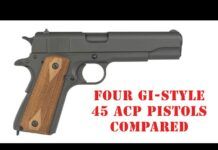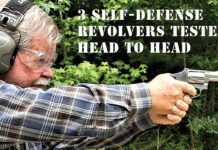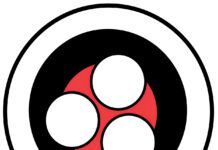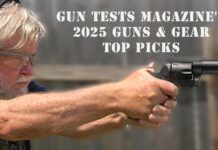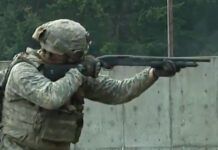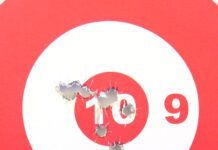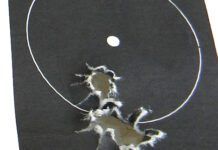
Looking for a bargain in firearms is usually a bad place to start, because, over the years we’ve found that in most cases, you get what you pay for. But on rare occasions, Gun Tests has found well-made, accurate, easy-to-shoot inexpensive firearms in all categories.
Perhaps one of the deepest segments in which to find a bargain is in .22 LR bolt actions, depending, of course, on your definition of bargain. What we wanted to find in this test was a step up from plinker-grade guns that usually retail for $100 to $150, something that didn’t break the bank, yet shot accurately and had a good list of features—decent trigger, good stock, and wide application. That course led us to a trio of heavy-barreled products from CZ and Marlin, along with the H&R CM12 training rifle, available through the Civilian Marksmanship Program (CMP).
Of the three, the H&R CM12 has the most interesting story. The CMP has been making the H&R CM12 training rifle available to the public through its website and traditional mail resources. For shooters who can document any level of competition shooting activity (and the standards are very low as to what qualifies), the CM12 smallbore can be purchased for $300 by an adult, or only $250 for a junior competitive shooter. From traditional retail sources, we chose the two other bolt-action rifles in this price range. The CZ 452-2E ZKM and Marlin’s 880SQ have sporter stocks, but otherwise are built with accuracy in mind, just like the CM12. Also, we’ve seen street prices on both guns just a shade under $300.
The most important part of this test would be how accurate the guns were, plus their application across a range of smallbore uses. The winner would shoot the smallest groups and play in the most games—everything from popping cans to drilling holes in paper.
Setting up on a benchrest at 50 yards we equipped ourselves with a Ransom Master Rifle Rest and rear bunny bag to counter 6- to 10-mph crosswinds and the occasional 5-mph gust of 6 o’clock wind. The CM12 training rifle came with a set of genuine Redfield aperture sights which these days would (if you can get them) nearly justify the cost of the rifle alone. But since neither the CZ nor the Marlin was supplied with open sights, we chose to level the playing field with a Burris 3X- to 9X scope featuring a common crosshair reticle mounted in 1-inch Weaver tip-off rings. We chuckled as we fitted the rifles with a piece of glass ($207 at Natchez Shooting Supply, [800] 251-7839) that cost two-thirds of the gun’s prices. Also, to find out more about the handling of these rifles, we tried shooting groups from the three basic positions of standing, sitting, and prone.
Here’s what we found:
H&R CM12 (CMP)
Our recommendation: At $300 or less, this one’s a bargain. As a training rifle for adults, an accurate plinker, or a trainer for young shooters, the CM12 is worth every penny. Supplies may be limited from the Civilian Marksmanship Program, so if you snooze, you lose.
The CM12 is a heavy piece of equipment (12 pounds 9 ounces) and is long to boot (46 inches). Still, it is relatively easy to handle due to its balance and fully inletted walnut stock, which is flat on the forend.
Without doubt, the H&R CM12 was the accuracy champ from the rest. Consistency was the word of the day, as it showed narrow deviations in group sizes ammo to ammo and even identical averages of 0.60 inch from the Remington Golden Bullet and the Lapua Dominator. This type of performance puts the onus on the shooter, which is ideal for training.
Once we had determined the CM12 would whip the others in baseline accuracy, we worked up an appetite for tighter groups. Enter four more brands of ammo we knew from experience would likely shoot well. We tried Fiocchi’s Pistol V 300 Super Match and were rewarded with 0.4, 0.6, and 0.7-inch groups. Federal’s UM1 also dialed in an average group size of 0.6 inch. Eley’s Tenex shrank the average size to 0.5 inch, but the 40-grain RWS R50 round from Dynamit Nobel said pass the dice to me and shot average group sizes of 0.3 inch, including groups of 0.5, 0.3, and 0.2 inch.
In our view, the CM12 is accurate because the barrel and action float far enough from the stock so that there is enough room for the wooden stock to expand and contract without touching the barrel. This also insulates the barrel from deflection due to stress presented by the use of a tight sling.
Off the bench, the H&R surplus training rifle was likewise superior to both the Marlin and CZ. This could be attributed to built-in features that aid the shooter in each position. Starting at the front of the gun, these features include an oversized forend that fills the shooter’s hand in prone and kneeling, a full-length handstop rail, a big handgrip, and a high cheekpiece. The supplied Redfield aperture sights are a marvel in themselves, crisp and easy to adjust. Additionally, the barrel is way too heavy to flex, and heat is easily dissipated. The gun’s 21-ounce trigger reacts immediately.
This single shot has a generous opening at the chamber, which makes loading easy, and the oversized bolt’s double extractors crisply throw rounds out and away from the shooter.
CZ 452-2E ZKM Varmint
Our recommendation: If you don’t have a need for the heft or target stock of the CM12, this sporter-style heavy-barrel gun offers adequate accuracy for the money. There is nothing fancy about this rifle, but it shoots well and is constructed with simple classic appeal.
The CZ Varmint comes without the iron sights found on other models, but features a fine wood stock with nice checkering. The fittings for the swivels and the way this rifle is assembled make it as tight as many others costing far more. The shorter, but heavier, barrel is in balance with the rest of the gun, offering a completely neutral feel. The buttpad is soft rubber and isn’t tacky, so it absorbs what shock there is and protects the wood from damage when placed in a rack. The bolt is heavy and smooth in operation, but like the trigger seemed to benefit from break in. The trigger seemed rough at first but improved with each stroke. By the time we had fired it 150 or so times, the trigger pull broke at a smooth 3.0 pounds.
In terms of accuracy, the Lapua Dominator produced the smallest group in the CZ (0.60 inch), but its largest spread measured 1.3 inches. The CCI ammo averaged 0.9 inches per five-shot group. Our high-velocity round of choice, the 36-grain Golden Bullet hollow point from Remington, averaged nearly 1,200 fps but only produced one group below an inch, finally averaging 1.1 inches.
Five- and ten-round magazines are available from CZ, and they move easily in and out. Perhaps the release could be larger, however, in case the shooter was wearing gloves in cooler weather.
Marlin 880SQ
Our recommendation: The 880SQ, $294 street price, is a composite-stock gun suitable for rough field work. It could also be used for a young shooter or as a plinker because it is small and accurate enough, but other problems on the gun should discourage you from buying it, we feel.
Despite a somewhat gritty trigger that even after break-in resisted up to 5 pounds of finger pressure, the Marlin 880SQ posted a group as small as 0.3 inch with the CCI cartridge, and a group average of 0.7 inches. Firing the Green Tag ammunition, the 880SQ was edged out only by the H&R M12. Shooting the Remington and Lapua ammunition, the Marlin was 0.1 inch behind the CZ in average group size. Unlike the other guns, when we were shooting the Marlin, we were disappointed to find that our point of impact was substantially different for each brand of ammunition despite a consistent point of aim.
Thus, in terms of baseline accuracy off the bench, the Marlin held up fairly well. But how was it in the shooter’s hands? In our view, the light stock forces you to hold it tighter to the shoulder to make up for the muzzle heavy feel. The trigger action is heavy, and its narrow surface is serrated, neither of which is overly comfortable. Its overall balance made us very aware of the heavy bull barrel. For a little .22 rifle, it takes a lot of strength and dexterity to handle and shoot the Marlin, in our view.
The 880SQ suffered by comparison in other areas, we thought. The CZ could have used more material around the mag well for a better standing hold. Still, the CZ was well balanced. This paid off most notably from the prone position, and if the shooter was seated, the rifle seemed to fall right into position. Thus, the CZ was the least tiring of the three to shoot. In contrast, the Marlin, with its synthetic stock, was muzzle heavy, and this meant firing from the prone and seated positions was more difficult, forcing the forward hand further away from the body. The Marlin’s heavy trigger also hindered our ability to break shots at the proper moment, especially from the standing position.
The magazines are a far cry from the heavy steel mags packaged with the CZ. The mags hold seven rounds—an odd number—and their floorplates look as though they can be removed for cleaning, but not without some struggle and possible damage. Internally, the Marlin magazines have springs that look weak, but we encountered no reliability problems in the test. Releasing the mag requires pushing the lever behind the mag to the rear. We haven’t found a way to remove the mag with one hand yet. These impressions along with the loud “clack” that echos through the hollow stock as the trigger releases gives the Marlin a cheaper feel than the other guns.
Part of our test program was to clean the barrels after each brand of ammunition was fired. The CZ would clean up easily and quickly, but the Marlin fouled more readily and was harder to get clean. Indeed, inspection of the Marlin’s bore even before our test showed extensive debris. It likely could do with a good lapping job.
Gun Tests Recommends
H&R CM12, $250 to $300. Buy It. If you want an adequate target gun for a bargain-basement price, call the CMP and get it. However, its physical dimensions make it a poor choice for field work.
CZ 452-2E ZKM Varmint, $300. Buy It. For a first rifle, this gun is a good buy, and would likely last a lifetime. It would also be a good plinker or varminter for adults, and with the right ammo, it could be competitive in smallbore silhouette. Also, this particular rifle improved the more we fired it. Ten-round mags are available. The quality of the stock, fit, and finish are more than we would expect for this low price.
Marlin 880SQ, $294. Don’t Buy It. Despite the advantages a synthetic stock might have in bad weather, we didn’t feel confident that the construction of the mags nor the machining of the bolt would remain precise. This was the only gun in the test that looked and felt like a low-end product.




